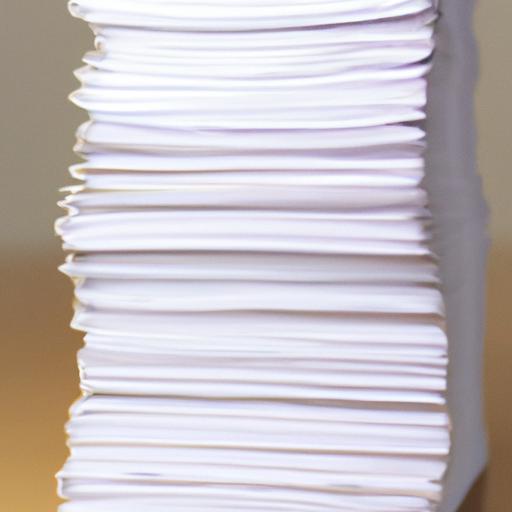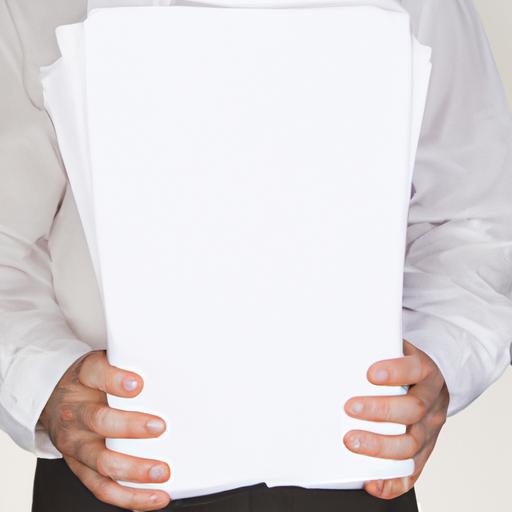How Much Paper is in a Ream?
Table of Contents
As someone who uses paper regularly, whether for personal or professional purposes, you might have come across the term “ream of paper.” A ream of paper is a standard measurement of paper that is widely used in the printing and paper manufacturing industry. In this article, we will discuss the basics of paper measurement and understand how much paper is in a ream.
Understanding Paper Measurement

Before we dive into how much paper is in a ream, let’s understand the different metrics used to measure paper. The two primary metrics used to measure paper are basis weight and ream weight.
Basis Weight
Basis weight is the weight of a paper sheet in pounds, expressed in the United States as weight per 500 sheets (sometimes abbreviated as “lb.” or “#”). This weight is determined by weighing a sample of 500 sheets of a particular size, known as the “basic size.” For instance, if a particular paper has a basis weight of 20 lb., it means that 500 sheets of that paper, measuring 17″ x 22″, weigh 20 pounds.
Ream Weight
Ream weight, also known as case weight, is the total weight of a ream of paper, including the weight of the paper and the packaging. The ream weight varies depending on the number of sheets in a ream, the size of the paper, and the weight of the paper.
The sheet count is another metric used to measure paper. It refers to the number of sheets in a ream or a bundle of paper. The sheet count of a ream of paper typically ranges from 250 to 500, depending on the type and size of the paper.
Standard Size of a Ream of Paper
A standard ream of paper is typically made up of 500 sheets, although there are variations, such as 250 or 1,000 sheets. The size of the paper in a ream can vary depending on the intended use. The most common paper sizes are letter size (8.5″ x 11″), legal size (8.5″ x 14″), and tabloid size (11″ x 17″).
The weight of the paper in a ream can also vary depending on the intended use. The weight of the paper is measured in pounds (lb.) and can range from 20 lb. to 32 lb. Generally, lighter weight paper is used for everyday printing, while heavier weight paper is used for more professional printing, such as printing brochures, flyers, and booklets.
Now that we have discussed the basics of paper measurement and the standard size of a ream of paper, let’s move on to how to calculate the number of sheets in a ream.
Calculating the Number of Sheets in a Ream
(To be written)
Standard Size of a Ream of Paper
There are various paper sizes that a ream can come in. The most common paper sizes are letter size (8.5″ x 11″), legal size (8.5″ x 14″), and tabloid size (11″ x 17″). Other sizes include ledger size (11″ x 17″), statement size (5.5″ x 8.5″), and executive size (7.25″ x 10.5″). The size of the paper in a ream depends on the intended use.
The weight of the paper in a ream is also an important factor to consider. Common paper weights include 20 lb., 24 lb., 28 lb., and 32 lb. The weight of the paper is directly proportional to its thickness, stiffness, and opacity. The sheet count of a ream can also vary depending on the weight and size of the paper. The most common sheet count for a ream of paper is 500, but reams of 250 and 1,000 sheets are also available.
Calculating the Number of Sheets in a Ream
To calculate the number of sheets in a ream, you need to know the basis weight of the paper and the weight of a single sheet of paper. The formula for calculating the number of sheets in a ream is as follows:
Number of Sheets = (Ream Weight ÷ Basis Weight) × 500
For example, let’s say you have a ream of 20 lb. paper with a ream weight of 5 lbs. To calculate the number of sheets in the ream, you would use the following formula:
Number of Sheets = (5 ÷ 20) × 500 = 125 sheets
Therefore, there are 125 sheets of 20 lb. paper in a ream weighing 5 lbs.
Knowing how to calculate the number of sheets in a ream is essential as it helps you determine the cost-effectiveness of a particular paper brand and size. By calculating the number of sheets in a ream, you can also estimate the amount of paper needed for a particular printing job, saving you time and money.
In the next section, we will discuss the importance of knowing how much paper is in a ream.
Importance of Knowing How Much Paper is in a Ream
Knowing how much paper is in a ream can have several benefits.
Cost-effectiveness
Calculating the number of sheets in a ream can help you determine the cost-effectiveness of your paper usage. For instance, if you know that a particular ream of paper has 500 sheets, you can calculate the cost per sheet and compare it with other brands or types of paper. This information can help you make an informed decision when buying paper, ensuring that you get the best value for your money.
Time-saving
Knowing how much paper is in a ream can also be time-saving. For instance, if you have a large printing project and need to know how many reams of paper you need, you can quickly calculate the number of sheets required and order the necessary amount. This information can save you time and prevent you from over-ordering or under-ordering paper.
Environmental Impact
Calculating the number of sheets in a ream can also have a positive impact on the environment. By understanding how much paper is in a ream, you can reduce paper waste by ordering only the amount of paper you need. This can help reduce the amount of paper that ends up in landfills and promote sustainable paper usage.
Conclusion
In conclusion, a ream of paper is a standard measurement of paper that is widely used in the printing and paper manufacturing industry. Understanding paper measurement, the standard size of a ream of paper, and calculating the number of sheets in a ream can have several benefits, including cost-effectiveness, time-saving, and environmental impact. By knowing how much paper is in a ream, you can make informed decisions when buying paper, reduce paper waste, and promote sustainable paper usage.

